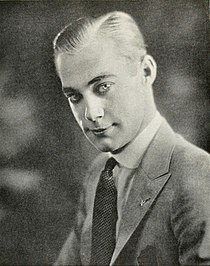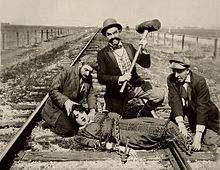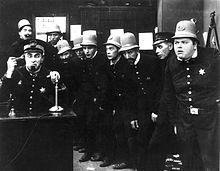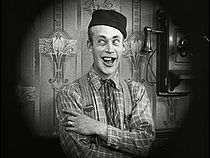| This article needs additional citations for verification. Please help improve this article by adding citations to reliable sources. Unsourced material may be challenged and removed. Find sources: "Al St. John" – news · newspapers · books · scholar · JSTOR (March 2014) (Learn how and when to remove this message) |
| Al St. John | |
|---|---|
 Who's Who on the Screen, 1920 Who's Who on the Screen, 1920 | |
| Born | Alfred St. John (1892-09-10)September 10, 1892 Santa Ana, California, US |
| Died | January 21, 1963(1963-01-21) (aged 70) Lyons, Georgia, US |
| Occupations |
|
| Years active | 1912–1962 |
| Spouses |
|
| Children | 1 |
| Relatives | Roscoe "Fatty" Arbuckle (uncle) |
Al St. John (also credited as Al Saint John and "Fuzzy" St. John; September 10, 1892 – January 21, 1963) was an early American motion-picture comedian. He was a nephew of silent film star Roscoe "Fatty" Arbuckle, with whom he often performed on screen. St. John was employed by Mack Sennett and also worked with many other leading players such as Charlie Chaplin, Buster Keaton and Mabel Normand. His film career successfully transitioned from the silent era into sound, and by the late 1930s and 1940s he was working predominantly in Westerns, often portraying the scruffy comedy-relief character "Fuzzy Q. Jones". Among his notable performances in that role are in the "Billy the Kid" series of films released by the Producers Releasing Corporation from 1940 to 1946 and in that company's "Lone Rider" series from 1941 to 1943.
Early life, family and education
| This section needs expansion. You can help by adding to it. (January 2022) |
Alfred St. John was born in Santa Ana, California. He was the only child of parents Walter St. John, who supported the family initially as a farm laborer and later as a house builder, and Nora N. St. John (née Arbuckle), who was the older sister of actor Roscoe "Fatty" Arbuckle. His uncle Roscoe was five years older than Alfred. In Los Angeles, he lived in the fashionable West Adams district at 4300 Victoria Park Drive in the neighborhood of Victoria Park.
Career



Young "Al" entered silent films in 1911 to work as an extra and in minor character roles. Soon, however, he graduated to co-starring and then to starring roles in comedy shorts for a variety of studios.
St. John frequently appeared as Arbuckle's mischievously villainous rival for the attentions of leading ladies such as Mabel Normand and Minta Durfee. He worked with Arbuckle and Charles Chaplin in The Rounders (1914), although his most critically praised film during this period with Arbuckle remains Fatty and Mabel Adrift (1916). In France, he was billed as "Picratt."

When Arbuckle formed his own production company, he brought St. John with him and recruited stage star Buster Keaton into his films, creating a formidable roughhouse trio. After Arbuckle was involved in a widely publicized scandal that prevented him from appearing in movies, he pseudonymously directed his nephew Al as a comic leading man in silent and sound films such as The Iron Mule (1925) and Bridge Wives (1932). Dozens of St. John's early films were screened during the 56-film Arbuckle retrospective at the Museum of Modern Art in New York City in 2006.
As St. John's screen career continued through the 1930s, he was increasingly cast as scruffy, bearded comic characters. He appears, for example, in this type of role in Buster Keaton's 1937 comedy short Love Nest on Wheels, portraying the hillbilly character Uncle Jed. That same year he began supporting cowboy stars Fred Scott and later Jack Randall, but most of his films were made for Poverty Row studio Producers Releasing Corporation (PRC). For that studio, he played "Fuzzy Q. Jones" in the Billy the Kid series starring Bob Steele, the Lone Rider series (starring George Houston and later Bob Livingston), and the Billy the Kid/Billy Carson series starring Buster Crabbe.

The name "Fuzzy" originally belonged to a different actor, John Forrest “Fuzzy“ Knight, who took on the role of "cowboy sidekick" before St. John. The studio first intended to hire Knight for the Western series, but then gave the role to St. John, who took on the nickname of his rival for his screen character.
Exhibitors loved Fuzzy, who could be counted on to attract moviegoers. Fuzzy's character was the main box-office draw in these films when shown in England and Europe. These ultra-low-budget Westerns took only a bit more than a week to film, so that Crabbe and St. John made 36 films together in a surprisingly short time. When Crabbe left PRC (according to interviews, in disgust at the productions' increasingly low budgets), St. John was paired with new star Lash LaRue. Ultimately, St. John performed in more than 80 Westerns as Fuzzy.
St. John also created a character, "Stoney," in the film The Law of the 45's that later appeared, but played by different actors (including John Wayne), in the continuing Western film series The Three Mesquiteers.
St. John acted in more than 350 films during his screen career, which spanned the years 1911 through 1952.
Final years
For a decade after the end of his motion-picture career, he made assorted personal appearances at fairs, rodeos, on television, and at overseas US military bases. He also performed with traveling live-action productions such as the Tommy Scott Wild West Show.
St. John's death on January 21, 1963, occurred while he was touring with Scott. According to his obituaries, he suffered a massive heart attack at a motel in Lyons, Georgia, as he prepared for a special appearance at a nearby American Legion club. It was also widely reported in news accounts that the 70-year-old veteran entertainer died at the motel "in the arms of his wife, Flo-Bell Moore". After a private funeral service in Lyons, St. John's body was sent to Macon, Georgia for cremation. His ashes were then transferred to Homosassa Springs, Florida, where they were "deposited" at Fuzzy and Flo-Bell's permanent residence on the couple's "Double F Ranch".
Filmography
References
- "Al St. John marital history". b-westerns.com. Retrieved March 11, 2014.
- "Al St. John". Los Angeles Times. Retrieved 2023-01-21.
- "St. John, Al", Motion Picture Studio Directory and Trade Annual, 1921. New York: Motion Picture News, Inc., 1921, p. 203. Internet Archive, San Francisco. Retrieved February 7, 2021.
- "Twelfth Census of the United States: 1900", digital image of original enumeration page, St. John household, 18 June 1900, San Jose Township Pamona City Ward 5, Los Angeles, California; "Thirteenth Census of the United States: 1910", image of original enumeration page, 19 April 1910, District 75, 91, Los Angeles, California; Bureau of the Census, Washington, D.C. FamilySearch Archives.
- Fleming, E.J. (24 August 2010). The Movieland Directory. McFarland, Incorporated. ISBN 9780786443376. Retrieved 11 August 2023.
- ^ "Al St. John Veteran Film Comic Dies", extended obituary, The Arizona Republic (Phoenix), 22 January 1963, p. 24. ProQuest.
- Sweeney, Kevin W. (2007). Buster Keaton Interviews. Jackson: University Press of Mississippi. p. 152. ISBN 978-1-57806-963-7.
- Eagan, Daniel. "More on Fatty Arbuckle: His Films and His Legacy". Smithsonian Magazine, November 16, 2011. Smithsonian Institution, Washington, D.C. Retrieved February 8, 2021.
- "Love Nest on Wheels (1937)", cast credits, catalogue, British Film Institute, London. Retrieved February 7, 2021.
- Corneau, Ernest. Hall of Fame of Western Film Stars. Christopher Publishing, 1969, p. 235.
- Pitts, Michael R. Poverty Row Studios, 1929-1940: An Illustrated History of 55 Independent Film Companies, with a Filmography for Each McFarland, 2005, pp. 52-53.
- ^ "Al St. John, Western Star, Dies in Lyons", The Atlanta Constitution, 22 January 1963, p. 32. ProQuest Historical Newspapers, Ann Arbor, Michigan; subscription access through The University of North Carolina at Chapel Hill Library.
- "Al St. John, Western Film Comic, Dies", obituary Los Angeles Times, 22 January 1963, p. 4. ProQuest.
Further reading
- Copeland, Bobby J. Fuzzy St. John: Our Fuzzy Q. Jones. Madison, North Carolina: Empire Publishing Company, 2010; ISBN 978-0-944019-57-3.
- Rothel, David. Those Great Cowboy Sidekicks. Lanham, Maryland: Scarecrow Press, 1984 ISBN 0810817071.
External links
- Official website Run by the Estate of Al St. John
- "Saddle Pals & Sidekicks: Al 'Fuzzy' St. John", Old Corral Website
- Al St. John at IMDb
- Al St. John at Virtual History
- Al St. John in Bridge Wives on YouTube
- 1892 births
- 1963 deaths
- 20th-century American comedians
- 20th-century American male actors
- American male comedians
- American male film actors
- American male silent film actors
- Comedians from California
- Male Western (genre) film actors
- People from Lyons, Georgia
- People from Santa Ana, California
- Silent film comedians